An Integrated Modeling Approach for Forecasting Long-Term Energy Demand in Pakistan
Abstract
1. Introduction
2. Overview of the Energy System in Pakistan
2.1. Historical Energy Demand and Supply
2.2. Power and Energy Demand Forecasting Efforts
- (a)
- Primary energy/capita = 0.024 + 2.831 Real GDP/Capita + Residual,
- (b)
- Residential Electricity demand/connection = 673 + 0.012 Real GDP/Capita + Residual,
- (c)
- Residential sector Natural gas demand: From 2014, onwards the demand for natural gas/customer is being considered at 2014 level with an increase in gas connections by 5% each year,
- (d)
- Residential sector LPG: LPG spend = 0.286 × Natural gas spend,
- (e)
- Residential sector oil: Oil spend = 26,306 − 0.433 × LPG spend,
- (f)
- Industrial fuel demand: Industrial fuel demand = 1.373 + 0.0001 Real GDP Manufacturing,
- (g)
- Transport Sector Fuel: Road Transport Demand = −6.550 + 0.276 Real GDP + 0.093 Population − 0.045 Fuel Prices,
- (h)
- Commercial Electricity Spend = 10,287 + 9.007 Real GDP Services + Residual; Commercial Natural Gas = −7532 + 2.572 Real GDP Services,
- (i)
- Commercial sector LPG + Gas spend = −24,917 + 5.886 Real GDP Services + Residual,
- (j)
- Agriculture and Government Electricity spend = 7.651 Real GDP + Residual and
- (k)
- Agriculture and Government fuel spend = 2.118 Real GDP + Residual.
2.3. Economic Growth and Energy Consumption
3. Methodological and Theoretical Framework
3.1. Autoregressive Integrated Moving Average (ARIMA) and Holt-Winter Approach
3.2. The Long-Range Energy Alternatives Planning (LEAP) Tool
- The analysis is carried out sector by sector having the time series energy demand data of each fuel called demand devices that is defined by the user. Thus, a “hierarchical tree,” is generated; where the higher branches of the tree sums up the energy demand of all lower branches. This hierarchy might consist of: sectors, sub-sectors, end-uses and fuels/devices.
- In most of the cases, the product of activity and the energy intensity (i.e., demand per unit of the activity) is used to obtain the demand at the disaggregated levels. However, the model allows alternative options and in our case, we used the linear forecasting function to obtain results that were based on the time series historical data used in this study.
4. Results and Discussions
5. Conclusions and Recommendations
Acknowledgments
Author Contributions
Conflicts of Interest
References
- Ediger, V.Ş.; Tathdil, H. Forecasting the primary energy demand in Turkey and analysis of cyclic patterns. Energy Convers. Manag. 2002, 43, 437–487. [Google Scholar] [CrossRef]
- Saab, S.; Badr, E.; Nasr, G. Univariate modeling and forecasting of energy consumption: The case of electricity in Lebanon. Energy 2001, 26, 1–14. [Google Scholar] [CrossRef]
- Valasai, G.D.; Uqaili, M.A.; Memon, H.R.; Samoo, R.S.; Mirjat, N.H.; Harijanb, K. Overcoming electricity crisis in Pakistan: A review of sustainable electricity options. Renew. Sustain. Energy Rev. 2017, 72, 734–745. [Google Scholar] [CrossRef]
- Lee, Y.-S.; Tong, L.-I. Forecasting energy consumption using a grey model improved by incorporating genetic programming. Energy Convers. Manag. 2011, 52, 147–152. [Google Scholar] [CrossRef]
- Suganthi, L.; Samuel, A.A. Energy models for demand forecasting—A review. Renew. Sustain. Energy Rev. 2012, 16, 1223–1240. [Google Scholar] [CrossRef]
- Ediger, V.Ş.; Akar, S. ARIMA forecasting of primary energy demand by fuel in Turkey. Energy Policy 2007, 35, 1701–1708. [Google Scholar] [CrossRef]
- Erdogdu, E. Electricity demand analysis using cointegration and ARIMA modelling: A case study of Turkey. Energy Policy 2007, 35, 1129–1146. [Google Scholar] [CrossRef]
- Erdogdu, E. Natural gas demand in Turkey. Appl. Energy 2010, 87, 211–219. [Google Scholar] [CrossRef]
- Kankal, M.; Akpınar, A.; Kömürcü, M.İ.; Özşahin, T.Ş. Modeling and forecasting of Turkey’s energy consumption using socio-economic and demographic variables. Appl. Energy 2011, 88, 1927–1939. [Google Scholar] [CrossRef]
- Kaynar, O.; Yilmaz, I.; Demirkoparan, F. Forecasting of natural gas consumption with neural network and neuro fuzzy system. Energy Educ. Sci. Technol. A Energy Sci. Res. 2011, 26, 221–238. [Google Scholar]
- Pao, H.-T.; Tsai, C.-M. Modeling and forecasting the CO2 emissions, energy consumption, and economic growth in Brazil. Energy 2011, 36, 2450–2458. [Google Scholar] [CrossRef]
- Pan, C.T.; Hu, J.L.; Tso, C. Energy demand forecasting for Taiwan’s electronics industry. Actual Probl. Econ. 2012, 138, 440–447. [Google Scholar]
- Voronin, S.; Partanen, J. Forecasting electricity price and demand using a hybrid approach based on wavelet transform, ARIMA and neural networks. Int. J. Energy Res. 2014, 38, 626–637. [Google Scholar] [CrossRef]
- Deka, A.; Hamta, N.; Esmaeilian, B.; Behdad, S. Predictive Modeling Techniques to Forecast Energy Demand in the United States: A Focus on Economic and Demographic Factors. J. Energy Resour. Technol. 2015, 138, 022001. [Google Scholar] [CrossRef]
- Xiao, J.; Sun, H.; Hu, Y.; Xiao, Y. GMDH Based Auto-regressive Model for China’s Energy Consumption Prediction. In Proceedings of the International Conference on IEEE Logistics, Informatics and Service Sciences (LISS), Barcelona, Spain, 27–29 July 2015; pp. 1–6. [Google Scholar]
- Akpinar, M.; Yumusak, N. Year Ahead Demand Forecast of City Natural Gas Using Seasonal Time Series Methods. Energies 2016, 9, 727. [Google Scholar] [CrossRef]
- Asumadu-Sarkodie, S.; Owusu, P.A. Forecasting Nigeria’s energy use by 2030, an econometric approach. Energy Sources B Econ. Plan. Policy 2016, 11, 990–997. [Google Scholar] [CrossRef]
- Chai, J.; Lu, Q.-Y.; Wang, S.-Y.; Lai, K.K. Analysis of road transportation energy consumption demand in China. Transp. Res. Part D Transp. Environ. 2016, 48, 112–124. [Google Scholar] [CrossRef]
- Hussain, A.; Rahman, M.; Memon, J.A. Forecasting electricity consumption in Pakistan: The way forward. Energy Policy 2016, 90, 73–80. [Google Scholar] [CrossRef]
- Yuan, C.; Liu, S.; Fang, Z. Comparison of China’s primary energy consumption forecasting by using ARIMA (the autoregressive integrated moving average) model and GM(1,1) model. Energy 2016, 100, 384–390. [Google Scholar] [CrossRef]
- Galli, R. The relationship between energy intensity and income levels: Forecasting long term energy demand in Asian emerging countries. Energy J. 1998, 19, 85–105. [Google Scholar] [CrossRef]
- Huang, Y.; Bor, Y.J.; Peng, C.-Y. The long-term forecast of Taiwan’s energy supply and demand: LEAP model application. Energy Policy 2011, 39, 6790–6803. [Google Scholar] [CrossRef]
- Hyndman, R.J.; Fan, S. Density Forecasting for Long-Term Peak Electricity Demand. IEEE Trans. Power Syst. 2010, 25, 1142–1153. [Google Scholar] [CrossRef]
- Box, G.P.E.; Jenkins, G.M. Time Series Analysis: Forecasting and Control; Robinson, E., Ed.; Holden Day: San Francisco, CA, USA, 1976. [Google Scholar]
- Mirjat, N.H.; Uqaili, M.A.; Harijan, K.; Valasai, G.D.; Shaikh, F.; Waris, M. A review of energy and power planning and policies of Pakistan. Renew. Sustain. Energy Rev. 2017, 79, 110–127. [Google Scholar] [CrossRef]
- Valasai, G.D.; Uqaili, M.A.; Memon, H.R.; Samoo, S.R.; Mirjat, N.H.; Harijan, K. Assessment of Renewable Energy for Electricity Generation: Using Pakistan TIMES Energy Model. Sindh Univ. Res. J. (Sci. Ser.) 2017, 48, 775–778. [Google Scholar]
- Valasai, G.D.; Mirjat, N.H.; Uqaili, M.A.; Memon, H.U.R.; Samoo, S.R.; Harijan, K. Decarbonization of Electricity Sector of Pakistan—An Application of Times Energy Model. JOCET 2017, 5, 507–511. [Google Scholar]
- Muneer, T.; Asif, M. Prospects for secure and sustainable electricity supply for Pakistan. Renew. Sustain. Energy Rev. 2007, 11, 654–671. [Google Scholar] [CrossRef]
- Khan, M.M.; Zaman, K.; Irfan, D.; Awan, U.; Ali, G.; Kyophilavong, P.; Shahbaz, M.; Naseem, I. Triangular relationship among energy consumption, air pollution and water resources in Pakistan. J. Clean. Prod. 2016, 112, 1375–1385. [Google Scholar] [CrossRef]
- Zuberi, M.J.S.; Ali, S.F. Greenhouse effect reduction by recovering energy from waste landfills in Pakistan. Renew. Sustain. Energy Rev. 2015, 44, 117–131. [Google Scholar] [CrossRef]
- Arshad, A.; Zakaria, M.; Junyang, X. Energy prices and economic growth in Pakistan: A macro-econometric analysis. Renew. Sustain. Energy Rev. 2016, 55, 25–33. [Google Scholar] [CrossRef]
- Alahdad, Z. Pakistan’s Energy Sector: From Crisis to Crisis–Breaking the Chain; Pakistan Institute of Development Economics: Islamabad, Pakistan, 2012; p. 50. [Google Scholar]
- Hydrocarbon Development Institute of Pakistan (HDIP). Pakistan Energy Yearbook 2015; HDIP, Ministry of Petroleum and Natural Resources: Islamabad, Pakistan, 2016; p. 147.
- Government of Pakistan (GOP). Policy Framework and Package of Incentives for Private Sector Power Generation Projects in Pakistan; GOP: Islamabad, Pakistan, 1994; p. 21.
- Aftab, S. Pakistan’s Energy Crisis: Causes, Consequences and Possible Remedies, in Expert Analysis; The Norwegian Peacebuilding Resource Centre (NOREF): Oslo, Norway, 2014; p. 6. [Google Scholar]
- Kessides, I.N. Chaos in power: Pakistan’s electricity crisis. Energy Policy 2013, 55, 271–285. [Google Scholar] [CrossRef]
- Mirza, U.; Ahmad, N.; Majeed, T.; Harijan, K. Wind energy development in Pakistan. Renew. Sustain. Energy Rev. 2007, 11, 2179–2190. [Google Scholar] [CrossRef]
- Shahzad, A.M.; Jamil, F. Decomposition Analysis of Energy Consumption Growth in Pakistan during 1990–2013; S3H Working Paper Series, School of Social Sciences and Humanities (S3H), School of Social Sciences and Humanities (S3H); National University of Sciences and Technology (NUST): Islamabad, Pakistan, 2015; p. 34. [Google Scholar]
- Khan, M.A.; Khan, J.A.; Ali, Z.; Ahmad, I.; Ahmad, M.N. The challenge of climate change and policy response in Pakistan. Environ. Earth Sci. 2016, 75, 412. [Google Scholar] [CrossRef]
- Javaid, M.A.; Hussain, S.; Maqsood, A.; Arshad, Z.; Arshad, M.A.; Idrees, M. Electrical Energy Crisis in Pakistan and Their Possible Solutions. Int. J. Basic Appl. Sci. 2011, 11, 38–52. [Google Scholar]
- Rauf, O.; Wang, S.; Yuan, P.; Tan, J. An overview of energy status and development in Pakistan. Renew. Sustain. Energy Rev. 2015, 48, 892–931. [Google Scholar] [CrossRef]
- Khokhar, S.G.; Min, Q.; Chu, X. Electricity crisis and energy efficiency to poultry production in Pakistan. World’s Poult. Sci. J. 2015, 71, 539–546. [Google Scholar] [CrossRef]
- Government of Pakistan (GOP). Energy Security Plan: Medium Term Develpment Framework; Ministry of Planning, Development and Reforms, Planning Comission of Pakistan: Islamabad, Pakistan, 2005.
- Petroleum Institute of Pakistan (PIP). Pakistan Energy Outlook, 2015; Petroleum Institute of Pakistan: Karachi, Pakistan, 2015; p. 148. [Google Scholar]
- National Transmission and Dispatch Comparny Limited (NTDC). Electricity Demand Forecast Based on Multiple Regression; Power Planning Wing: Islamabad, Pakistan, 2014; p. 111. [Google Scholar]
- Perwez, U.; Sohail, A.; Hassan, S.F.; Zia, U. The long-term forecast of Pakistan’s electricity supply and demand: An application of long range energy alternatives planning. Energy 2015, 93, 2423–2435. [Google Scholar] [CrossRef]
- Perwez, U.; Sohail, A. Forecasting of Pakistan’s Net Electricity Energy Consumption on the Basis of Energy Pathway Scenarios. Energy Procedia 2014, 61, 2403–2411. [Google Scholar] [CrossRef]
- International Resources Group (IRG). Pakistan Integrated Energy Model (Pak-IEM); Final Report Volume I, Model Design Report; Ministry of Planning and Development, Government of Pakistan, Developed by International Resources Group (IRG) for Asian Development Bank; IRG: Islamabad, Pakistan, 2010; p. 130. [Google Scholar]
- Hussain, N.; Uqaili, M.A.; Harijan, K.; Valasai, G. Pakistan’s Energy System: Integrated Energy Modeling and Formulation of National Energy Policies. In Proceedings of the 14th International Conference on Sustainable Energy Technologies, Nottingham, UK, 5–7 October 2015. [Google Scholar]
- Anwar, J. An Analysis of Energy Security Using the Partial Equilibrium Model: The Case of Pakistan. Pak. Dev. Rev. 2010, 49, 925–940. [Google Scholar]
- Anwar, J. Analysis of energy security, environmental emission and fuel import costs under energy import reduction targets: A case of Pakistan. Renew. Sustain. Energy Rev. 2016, 65, 1065–1078. [Google Scholar] [CrossRef]
- Shahbaz, M.; Zeshan, M.; Afza, T. Is energy consumption effective to spur economic growth in Pakistan? New evidence from bounds test to level relationships and Granger causality tests. Econ. Model. 2012, 29, 2310–2319. [Google Scholar] [CrossRef]
- Khan, M.A.; Ahmad, U. Energy Demand in Pakistan: A Disaggregate Analysis. Pak. Dev. Rev. 2008, 47, 437–455. [Google Scholar]
- Alam, S.; Fatima, A.; Butt, M.S. Sustainable development in Pakistan in the context of energy consumption demand and environmental degradation. J. Asian Econ. 2007, 18, 825–837. [Google Scholar] [CrossRef]
- Aqeel, A.; Butt, M.S. The relationship between energy consumption and economic growth in Pakistan. Asia-Pac. Dev. J. 2001, 8, 101–110. [Google Scholar]
- Sahir, M.H.; Qureshi, A.H. Specific concerns of Pakistan in the context of energy security issues and geopolitics of the region. Energy Policy 2007, 35, 2031–2037. [Google Scholar] [CrossRef]
- Ahmed, M.; Riaz, K.; Khan, M.A.; Bibi, S. Energy consumption–economic growth nexus for Pakistan: Taming the untamed. Renew. Sustain. Energy Rev. 2015, 52, 890–896. [Google Scholar] [CrossRef]
- Siddiqui, R. Energy and Economic Growth in Pakistan. Pak. Dev. Rev. 2004, 43, 175–200. [Google Scholar]
- Nasir, M.; Ur Rehman, F. Environmental Kuznets Curve for carbon emissions in Pakistan: An empirical investigation. Energy Policy 2011, 39, 1857–1864. [Google Scholar] [CrossRef]
- Shahbaz, M.; Lean, H.H. The dynamics of electricity consumption and economic growth: A revisit study of their causality in Pakistan. Energy 2012, 39, 146–153. [Google Scholar] [CrossRef]
- Hye, Q.M.A.; Riaz, S. Causality between Energy Consumption and Economic Growth: The Case of Pakistan. Lahore J. Econ. 2008, 13, 45–58. [Google Scholar]
- Zaman, K.; Khan, M.M.; Ahmad, M.; Rustam, R. Determinants of electricity consumption function in Pakistan: Old wine in a new bottle. Energy Policy 2012, 50, 623–634. [Google Scholar] [CrossRef]
- Raza, S.A.; Shahbaz, M.; Nguyen, D.K. Energy conservation policies, growth and trade performance: Evidence of feedback hypothesis in Pakistan. Energy Policy 2015, 80, 1–10. [Google Scholar] [CrossRef]
- Ahmed, K.; Shahbaz, M.; Qasim, A.; Long, W. The linkages between deforestation, energy and growth for environmental degradation in Pakistan. Ecol. Indic. 2015, 49, 95–103. [Google Scholar] [CrossRef]
- Komal, R.; Abbas, F. Linking financial development, economic growth and energy consumption in Pakistan. Renew. Sustain. Energy Rev. 2015, 44, 211–220. [Google Scholar] [CrossRef]
- Shahbaz, M.; Lean, H.H.; Farooq, A. Natural gas consumption and economic growth in Pakistan. Renew. Sustain. Energy Rev. 2013, 18, 87–94. [Google Scholar] [CrossRef]
- Shahbaz, M.; Loganathan, N.; Zeshan, M.; Zaman, K. Does renewable energy consumption add in economic growth? An application of auto-regressive distributed lag model in Pakistan. Renew. Sustain. Energy Rev. 2015, 44, 576–585. [Google Scholar] [CrossRef]
- Ali, G.; Abbas, S. Exploring CO2 Sources and Sinks Nexus through Integrated Approach: Insight from Pakistan. J. Environ. Inform. 2013, 12, 112–122. [Google Scholar]
- Ediger, V.Ş.; Akar, S.; Uğurlu, B. Forecasting production of fossil fuel sources in Turkey using a comparative regression and ARIMA model. Energy Policy 2006, 34, 3836–3846. [Google Scholar] [CrossRef]
- Eldali, F.A.; Hansen, T.M.; Suryanarayanan, S.; Chong, E.K. Employing ARIMA Models to Improve Wind Power Forecasts: A Case Study in ERCOT. In Proceedings of the North American Power Symposium (NAPS), Denver, CO, USA, 18–10 Septemer 2016; pp. 1–6. [Google Scholar]
- Khan, Z.A.; Wazir, R. Techno-Economic Study for 50 MW Wind Farm in Pasni, Coastal District of Balochistan-Pakistan using ARIMA Models and RETScreen. In Proceedings of the 2014 International Conference on IEEE Energy Systems and Policies (ICESP), Islamabad, Pakistan, 24–26 November 2014; pp. 1–5. [Google Scholar]
- Sen, P.; Roy, M.; Pal, P. Application of ARIMA for forecasting energy consumption and GHG emission: A case study of an Indian pig iron manufacturing organization. Energy 2016, 116, 1031–1038. [Google Scholar] [CrossRef]
- Barak, S.; Sadegh, S.S. Forecasting energy consumption using ensemble ARIMA–ANFIS hybrid algorithm. Int. J. Electr. Power Energy Syst. 2016, 82, 92–104. [Google Scholar] [CrossRef]
- Martínez-Álvarez, F.; Troncoso, A.; Asencio-Cortés, G.; Riquelme, J. A Survey on Data Mining Techniques Applied to Electricity-Related Time Series Forecasting. Energies 2015, 8, 13162–13193. [Google Scholar] [CrossRef]
- Bhattacharyya, S.C.; Timilsina, G.R. Energy Demand Models for Policy Formulation, in A Comparative Study of Energy Demand Models; Environment and Energy Team Development Research Group, The World Bank: Washington, DC, USA, 2009; p. 151. [Google Scholar]
- Shaikh, F.; Ji, Q.; Fan, Y. The diagnosis of an electricity crisis and alternative energy development in Pakistan. Renew. Sustain. Energy Rev. 2015, 52, 1172–1185. [Google Scholar] [CrossRef]
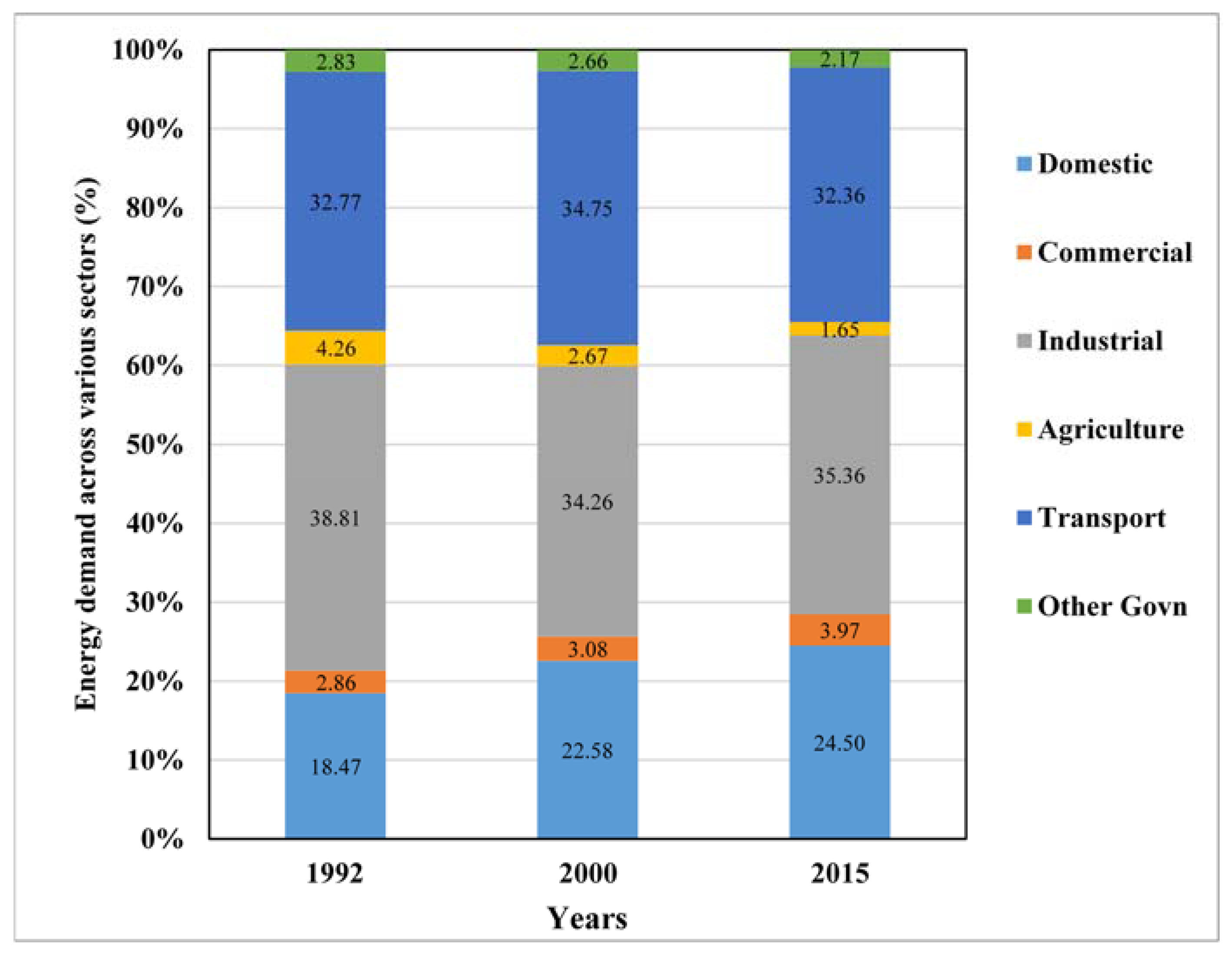
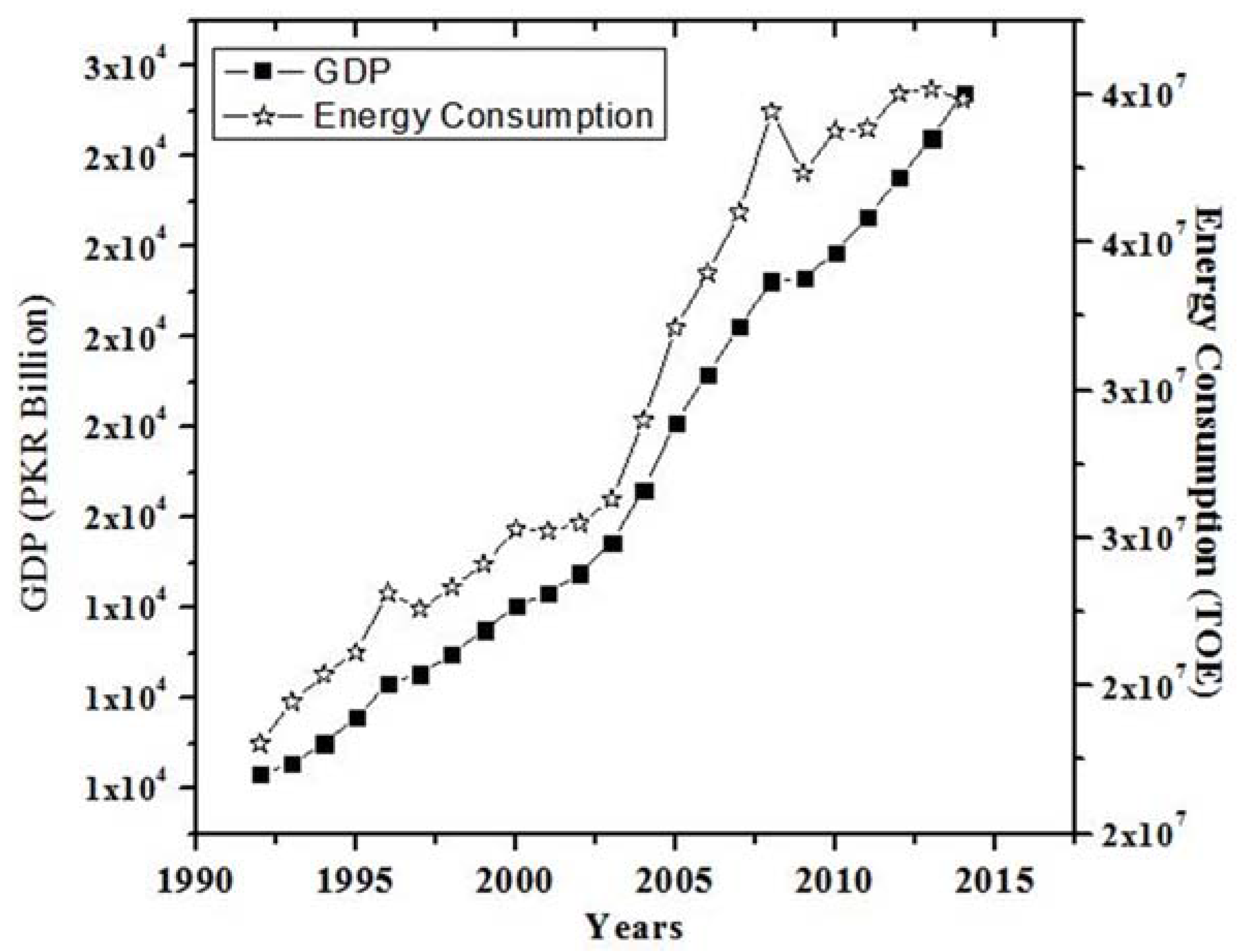
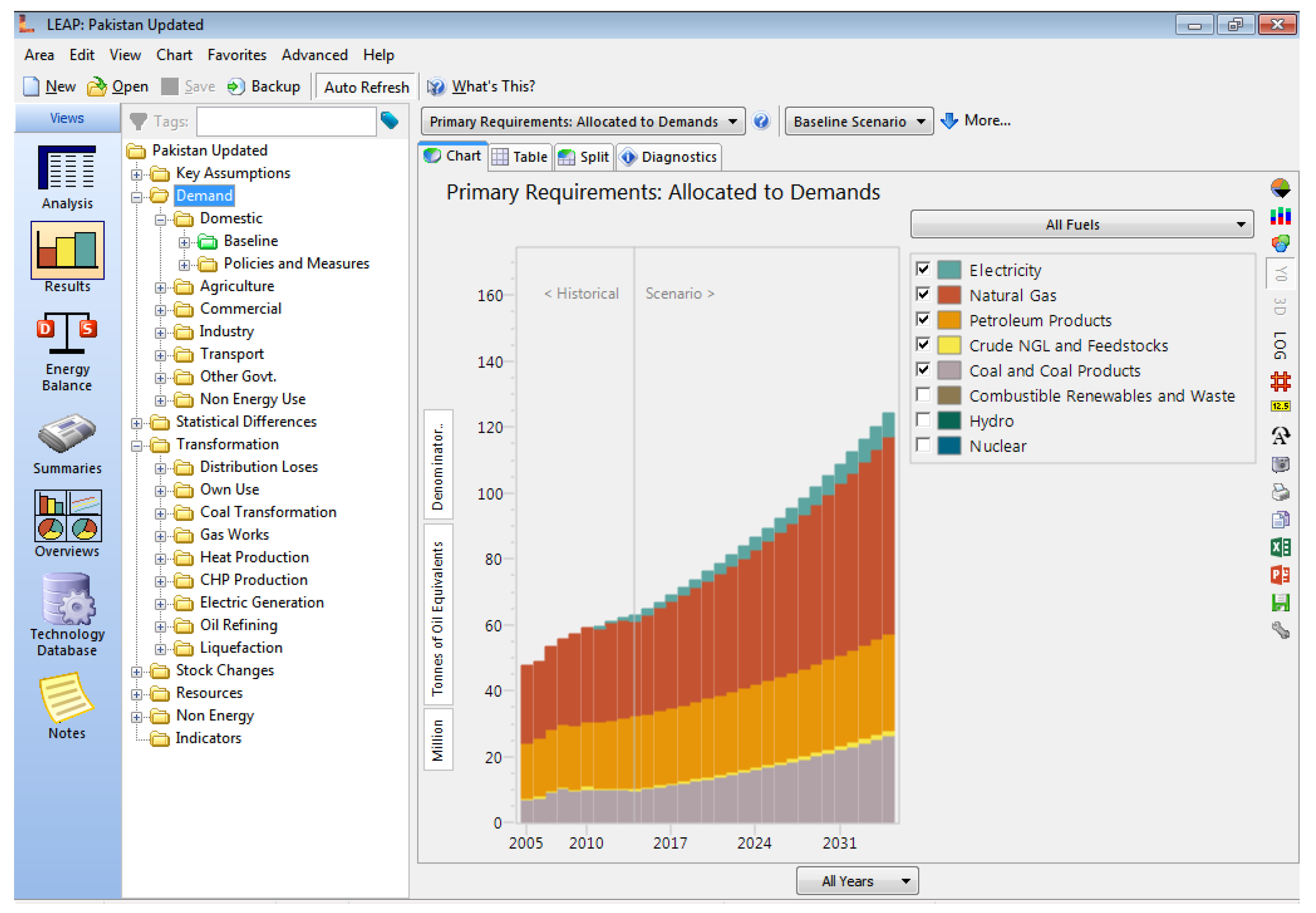
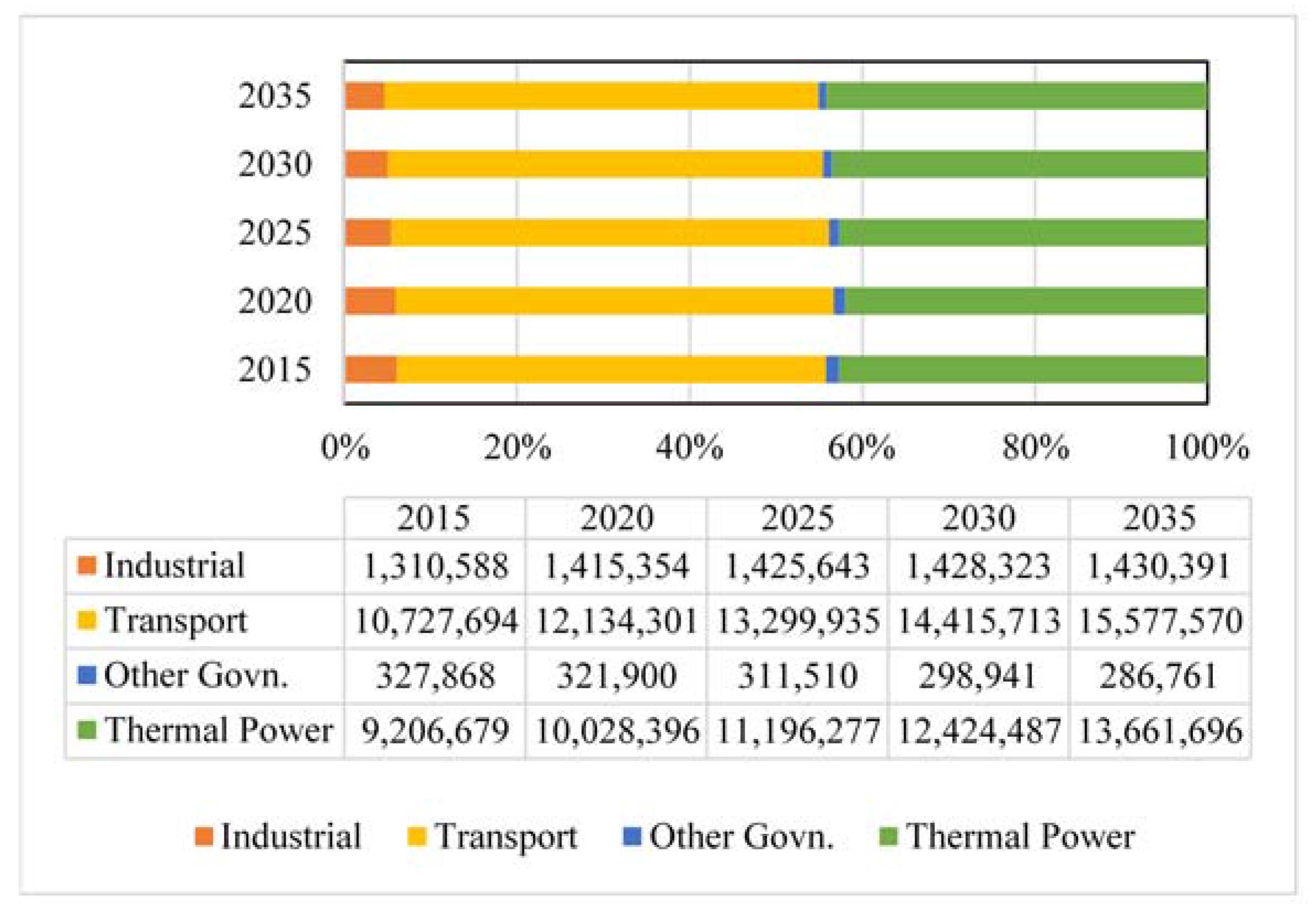
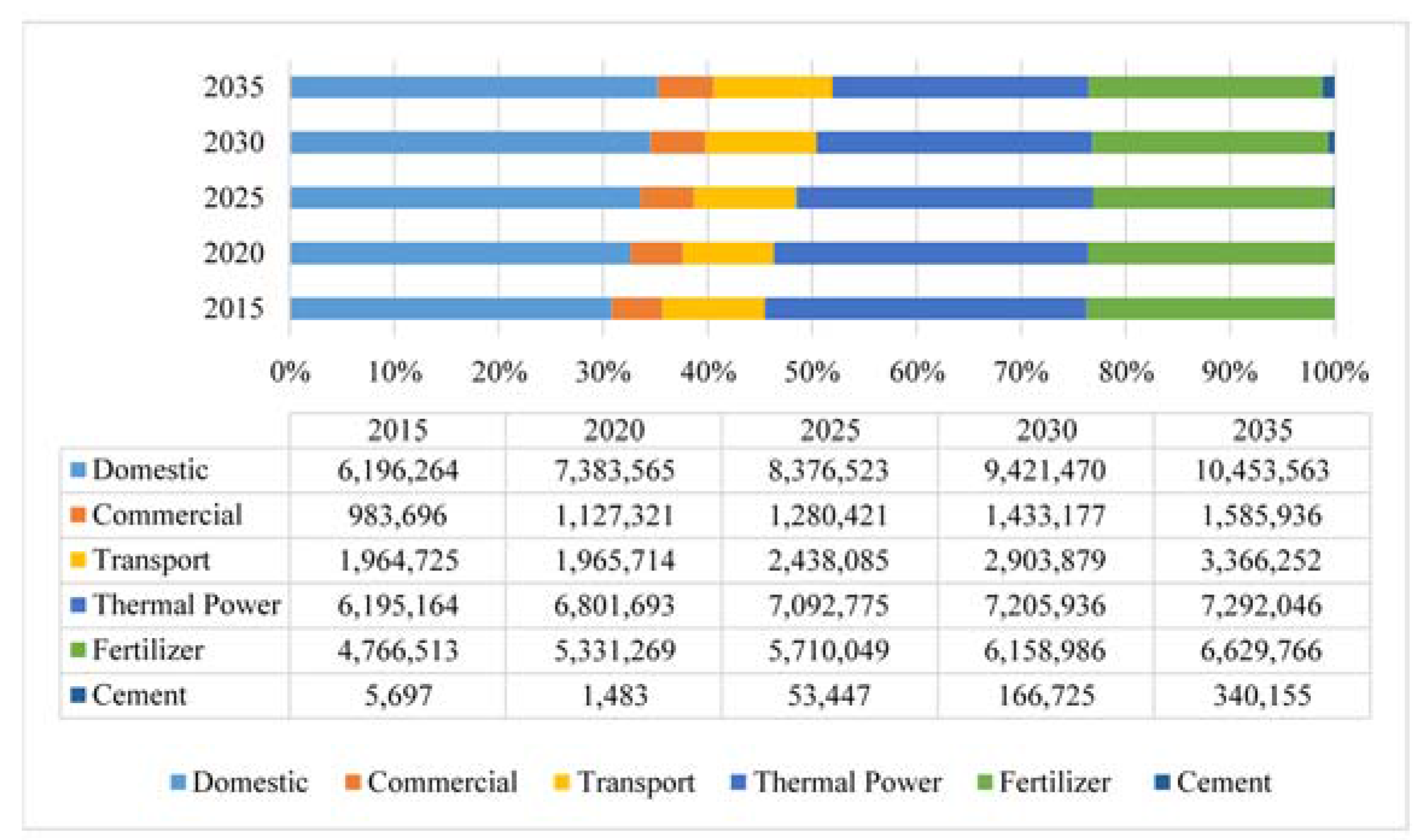
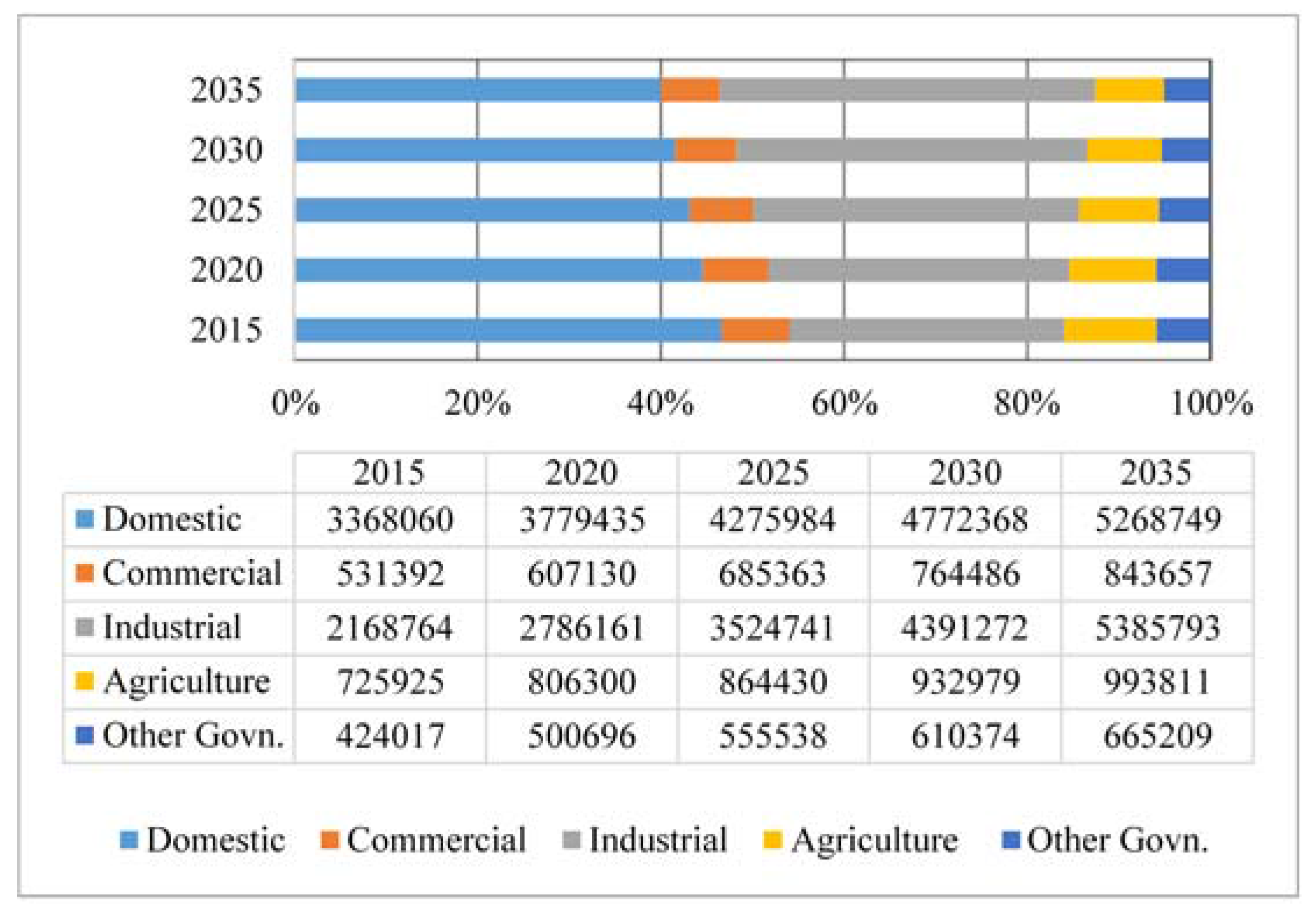
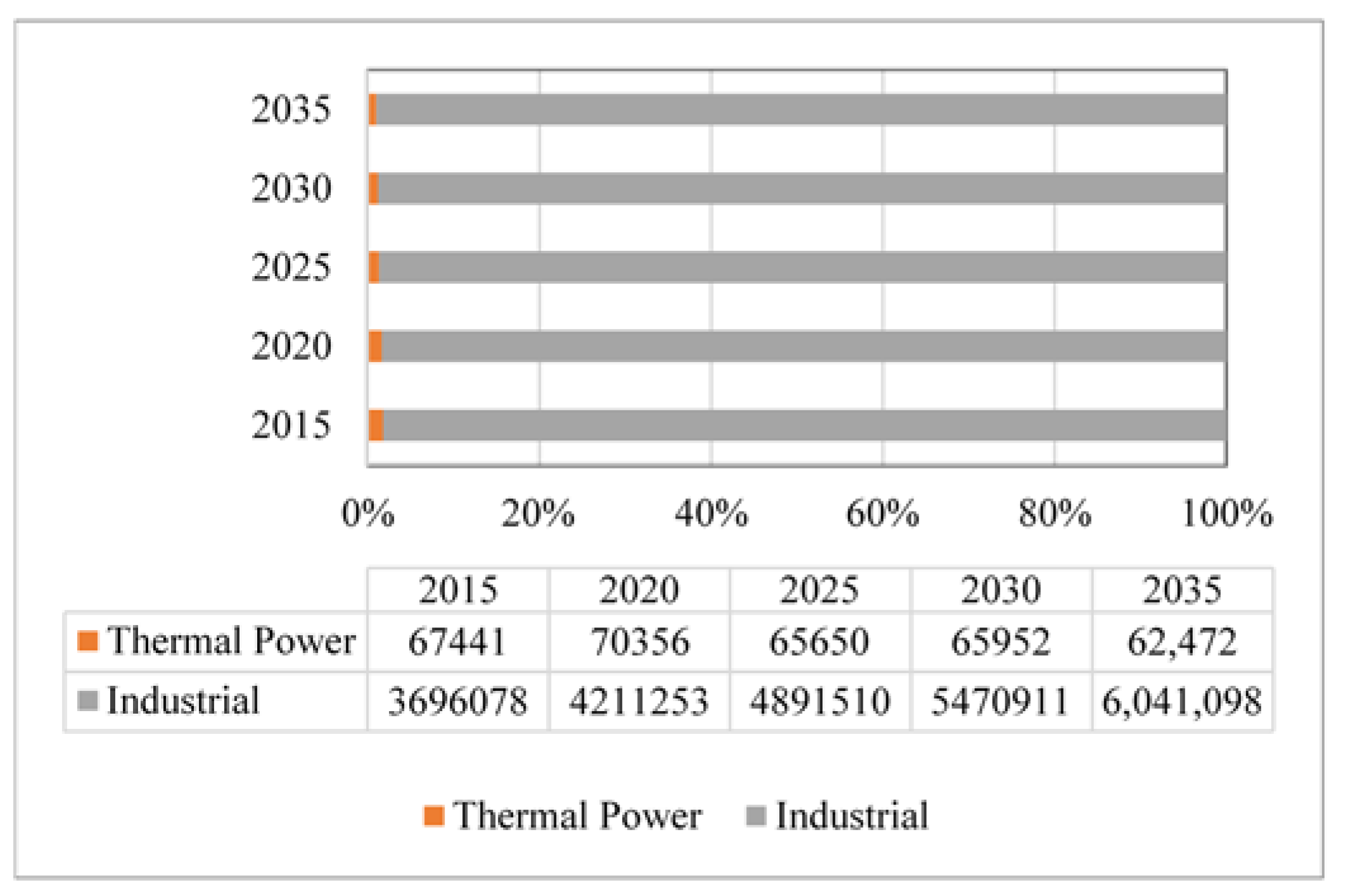
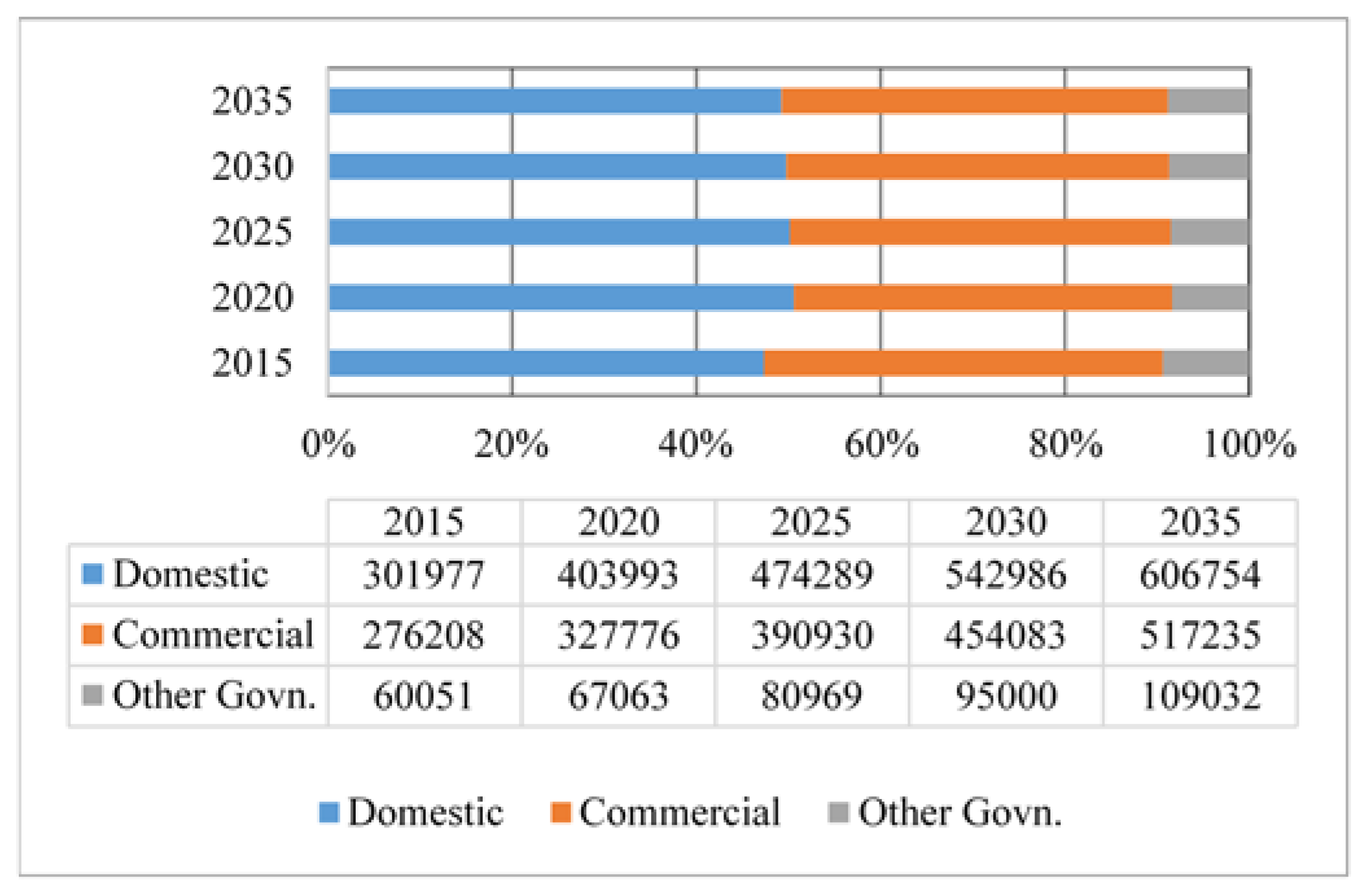
| Reference | Scope | Country/Location | Forecasting Method | Forecasting Horizon |
|---|---|---|---|---|
| [2] | Electricity | Lebanon | ARIMA | monthly |
| [6] | Primary energy demand | Turkey | ARIMA | 2005–2020 |
| [7] | Electricity | Turkey | ARIMA | 2005–2014 |
| [8] | Natural gas | Turkey | ARIMA | 2008–2030 |
| [9] | energy consumption | Turkey | ANN and regression analyses | 2008–2014 |
| [10] | Natural gas | Turkey | ARIMA, ANN moreover, neuro fuzzy system | weekly |
| [4] | Energy consumption | China | grey forecasting model and genetic programming | 1990–2007 |
| [11] | CO2 emissions, energy consumption and economic growth | Brazil | Grey prediction model | 2008–2013. |
| [12] | Energy demand | Taiwan | SARIMA model | 2010–2020 |
| [13] | Electricity price and demand | Finland | ARIMA and neural networks | day-ahead |
| [14] | Energy demand | USA | ANN, regression analysis Models and ARIMA | 2014–2019 |
| [15] | Oil, gas and total energy consumption | China | Group method of data handling (GMDH) and GMDH based auto-regressive (GAR) model. | 2014–2020 |
| [16] | Demand Forecast of Natural Gas | Sakarya, Turkey | time series decomposition, Holt-Winters, exponential smoothing and ARIMA | Year Ahead |
| [17] | Energy demand | Nigeria | ARIMA and ETS model | 2012–2030 |
| [18] | Energy consumption in road transportation | China | ETS & ARIMA models and multiple regression models | 2012–2020 |
| [19] | Electricity | Pakistan | Holt-Winter and ARIMA | 2012–2020 |
| [20] | Energy consumption | China | Comparison of ARIMA model and GM(1,1) model | 2014–2020 |
| [21] | Energy demand | 10 Asean countries | Log-linear and quadratic models | 1991–1995 |
| [22] | Energy demand and supply | Taiwan | LEAP | 2008–2030 |
| [23] | Electricity Demand | South Australia | semi-para-metric additive models | 2009–2019 |
| Fuel Type | Domestic | Commercial | Industrial * | Agriculture | Transport | Other Govt. | |
|---|---|---|---|---|---|---|---|
| Oil | 1992 | 8.56% | 0.42% | 15.48% | 3.39% | 68.25% | 3.90% |
| 2000 | 4.12% | 0.00% | 17.35% | 2.55% | 72.97% | 3.01% | |
| 2015 | 0.66% | 0.00% | 9.45% | 0.28% | 86.84% | 2.77% | |
| Natural gas | 1992 | 31.48% | 5.81% | 62.70% | 0.00% | 0.01% | 0.00% |
| 2000 | 40.47% | 6.28% | 52.55% | 0.00% | 0.70% | 0.00% | |
| 2015 | 41.30% | 5.23% | 43.60% | 0.00% | 9.88% | 0.00% | |
| Coal | 1992 | 0.22% | 0.00% | 99.78% | 0.00% | 0.00% | 0.00% |
| 2000 | 0.04% | 0.00% | 99.96% | 0.00% | 0.00% | 0.00% | |
| 2015 | 0.00% | 0.00% | 100.00% | 0.00% | 0.00% | 0.00% | |
| Electricity | 1992 | 33.82% | 6.33% | 36.27% | 17.26% | 0.09% | 6.23% |
| 2000 | 47.06% | 5.58% | 28.96% | 9.96% | 0.03% | 8.40% | |
| 2015 | 48.30% | 7.59% | 29.11% | 9.36% | 0.00% | 5.64% | |
| LPG | 1992 | 0.00% | 0.00% | 0.00% | 0.00% | 0.00% | 0.00% |
| 2000 | 75.00% | 25.00% | 0.00% | 0.00% | 0.00% | 0.00% | |
| 2015 | 41.33% | 41.16% | 0.00% | 0.00% | 0.00% | 17.51% |
| Years | Population (Million) | Total Primary Energy (MMTOE) | Power Gen. Installed Capacity (MW) | Natural Gas Consumption (MMcfd) | Energy Consumption per Capita (MMBtu) |
|---|---|---|---|---|---|
| 1950 | 35 | 1.4 | 115 | 0 | 1.7 |
| 1960 | 45 | 3.0 | 425 | 60 | 2.9 |
| 1970 | 60 | 6.4 | 1700 | 300 | 4.5 |
| 1980 | 81 | 12.5 | 3500 | 711 | 6.5 |
| 1990 | 108 | 28.0 | 9000 | 1364 | 10.9 |
| 2000 | 140 | 42.0 | 17,000 | 1950 | 12.5 |
| 2001 | 143 | 44.5 | 17,000 | 2104 | 13.0 |
| 2002 | 146 | 45.2 | 17,758 | 2259 | 13.0 |
| 2003 | 149 | 47.1 | 17,793 | 2390 | 13.2 |
| 2004 | 153 | 50.8 | 19,252 | 2881 | 13.9 |
| Holt-Winter Model | ARIMA Model | ||||
|---|---|---|---|---|---|
| Oil | |||||
| Sectors | RMSE | MAPE | RMSE | MAPE | |
| Domestic | 40,360.85 | 347,009.36 | Domestic | 40,896.30 | 374,545.26 |
| Industrial | 254,528.21 | 17,204,692.08 | Industrial | 193,848.31 | 19,926,731.58 |
| Agriculture | 9775.32 | 599,696.77 | Agriculture | 22,980.84 | 41,108.95 |
| Transport | 268,490.99 | 203,712,749.62 | Transport | 259,924.42 | 218,744,031.58 |
| Other Govt. | 17,779.68 | 7,833,528.41 | Other Govt. | 14,824.40 | 7,334,826.32 |
| Thermal power | 799,149.33 | 202,166,666.67 | Thermal power | 873,683.20 | 204,652,515.79 |
| Total | 619,458.79 | 226,401,119.29 | Total | 281,050.96 | 242,497,542.11 |
| Natural Gas | |||||
| Sectors | RMSE | MAPE | RMSE | MAPE | |
| Domestic | 315,295.30 | 117,830,812.05 | Domestic | 393,505.23 | 114,615,089.47 |
| Commercial | 32,735.15 | 20,261,815.06 | Commercial | 18,380.76 | 19,377,231.58 |
| Industrial | 828,429.06 | 194,360,295.26 | Industrial | 973,411.45 | 200,360,263.16 |
| Transport | 337,027.50 | 62,030,631.58 | Transport | 298,615.33 | 60,139,600.00 |
| Thermal power | 1,740,446.33 | 62,030,631.58 | Thermal power | 1,430,927.80 | 203,392,026.32 |
| Fertilizer | 398,245.11 | 98,858,980.12 | Fertilizer | 361,241.98 | 97,500,131.58 |
| Cement | 4496.79 | 303,019.88 | Cement | 73,340.75 | 3,186,778.95 |
| Total | 779,996.9699 | 388,296,359.8 | Total | 1,318,376.63 | 409,063,684.2 |
| Coal | |||||
| Sectors | RMSE | MAPE | RMSE | MAPE | |
| Industrial | 438,146.90 | 98,032,343.63 | Industrial | 312,017.10 | 91,851,315.79 |
| Thermal power | 15,141.33 | 1,630,728.77 | Thermal power | 10,236.35 | 1,355,226.84 |
| Total | 434,584.06 | 97,932,298.32 | Total | 327,510.99 | 91,443,421.05 |
| Electricity | |||||
| Sectors | RMSE | MAPE | RMSE | MAPE | |
| Domestic | 43,111.70 | 64,145,330.99 | Domestic | 74,797.57 | 66,065,505.26 |
| Commercial | 4276.77 | 10,279,323.34 | Commercial | 5206.46 | 10,389,873.68 |
| Industrial | 106,535.38 | 33,991,791.15 | Industrial | 98,136.80 | 34,248,889.47 |
| Agriculture | 65,271.88 | 16,938,946.78 | Agriculture | 46,860.02 | 16,212,347.37 |
| Other Govt. | 23,407.44 | 9,303,922.66 | Other Govt. | 24,986.82 | 9,348,942.11 |
| Total | 71,061.12 | 135,683,521.63 | Total | 157,556.11 | 140,742,305.26 |
| LPG | |||||
| Sectors | RMSE | MAPE | RMSE | MAPE | |
| Domestic | 203,069.01 | 14,637,104.24 | Domestic | 199,105.33 | 14,344,631.58 |
| Commercial | 11,302.71 | 4,804,046.78 | Commercial | 20,044.11 | 5,273,536.84 |
| Other Govt. | 18,101.41 | 537,305.26 | Other Govt. | 16,751.25 | 606,368.42 |
| Total | 42,618.53 | 12,917,467.84 | Total | 67,738.42 | 14,105,568.42 |
| Sectors | Fuel Type | Parameters ARIMA (p,d,q) | Sectors | Fuel Type | Parameters ARIMA (p,d,q) |
|---|---|---|---|---|---|
| Domestic | Electricity | ARIMA (1,1,4) | Domestic | Natural Gas | ARIMA (1,1,4) |
| Industrial | Electricity | ARIMA (1,2,4) | Industrial | Natural Gas | ARIMA (1,2,5) |
| Commercial | Electricity | ARIMA (1,1,5) | Commercial | Natural Gas | ARIMA (1,1,5) |
| Agriculture | Electricity | ARIMA (2,1,3) | Transportation | Natural Gas | ARIMA (2,1,5) |
| Transportation | Electricity | ARIMA (1,1,3) | Thermal Power | Natural Gas | ARIMA (2,1,4) |
| Other Govt. | Electricity | ARIMA (1,1,3) | Domestic | Coal | ARIMA (1,1,2) |
| Domestic | Oil | ARIMA (2,1,5) | Industrial | Coal | ARIMA (2,1,5) |
| Industrial | Oil | ARIMA (1,1,2) | Thermal Power | Coal | ARIMA (2,1,3) |
| Commercial | Oil | ARIMA (2,1,3) | Domestic | LPG | ARIMA (2,1,3) |
| Agriculture | Oil | ARIMA (1,1,4) | Commercial | LPG | ARIMA (1,1,4) |
| Transportation | Oil | ARIMA (4,1,3) | Other Govt. | LPG | ARIMA (1,1,2) |
| Other Govt. | Oil | ARIMA (2,1,2) | |||
| Thermal Power | Oil | ARIMA (2,1,2) |
| Year | Domestic | Commercial | Industrial | Agriculture | Transport | Other Govt. | Total |
|---|---|---|---|---|---|---|---|
| 2015 | 9,939,306 | 1,791,296 | 33,642,419 | 764,450 | 12,692,419 | 811,936 | 59,641,826 |
| 2020 | 11,566,993 | 2,062,227 | 32,987,225 | 806,300 | 14,100,015 | 889,659 | 62,412,419 |
| 2025 | 13,126,796 | 2,356,714 | 33,960,092 | 864,430 | 15,738,020 | 948,017 | 66,994,069 |
| 2030 | 14,736,824 | 2,651,746 | 37,312,592 | 932,979 | 17,319,592 | 1,004,315 | 73,958,048 |
| 2035 | 16,329,066 | 2,946,828 | 40,843,417 | 993,811 | 18,943,822 | 1,061,002 | 81,117,946 |
| Years | Domestic | Commercial | Industrial | Agriculture | Other Govt. | |
|---|---|---|---|---|---|---|
| This study | 2015 | 39,171 | 6180 | 25,223 | 8443 | 4931 |
| [19] | 2015 | 40,820 | 6647 | 26,088 | 10,020 | 5210 |
| This study | 2020 | 43,955 | 7061 | 32,403 | 9377 | 5823 |
| [19] | 2020 | 47,046 | 7724 | 32,377 | 11,209 | 5843 |
| Year | Oil * | Natural Gas * | Fuel Wood | LPG † | Electricity * | ||||||||
|---|---|---|---|---|---|---|---|---|---|---|---|---|---|
| ARIMA ‡ | LEAP | Holt-Winter | ARIMA ‡ | LEAP | Holt-Winter | LEAP | ARIMA ‡ | LEAP | Holt-Winter | ARIMA ‡ | LEAP | Holt-Winter | |
| 2010 | 0.093 | 0.091 | 0.093 | 5.134 | 5.028 | 5.134 | 25.499 | 0.942 | 0.923 | 0.942 | 2.791 | 2.734 | 2.791 |
| 2015 | 0.073 | 0.105 | 0.068 | 6.196 | 6.366 | 6.599 | 28.642 | 0.302 | 0.262 | 0.572 | 3.368 | 3.256 | 3.311 |
| 2020 | −0.16 | 0.117 | −0.11 | 7.384 | 7.089 | 7.479 | 31.890 | 0.404 | 0.292 | 0.685 | 3.779 | 3.625 | 3.761 |
| 2025 | −0.39 | 0.129 | −0.29 | 8.377 | 7.808 | 8.359 | 35.127 | 0.474 | 0.322 | 0.797 | 4.276 | 3.993 | 4.212 |
| 2030 | −0.51 | 0.141 | −0.47 | 9.421 | 8.521 | 9.240 | 38.334 | 0.543 | 0.351 | 0.910 | 4.772 | 4.358 | 4.662 |
| 2035 | −0.67 | 0.152 | −0.66 | 10.454 | 9.232 | 10.120 | 41.533 | 0.607 | 0.380 | 1.022 | 5.269 | 4.721 | 5.112 |
| Year | Oil † | Natural Gas * | Coal † | Electricity † | |||||||||
|---|---|---|---|---|---|---|---|---|---|---|---|---|---|
| ARIMA ‡ | LEAP | Holt-Winter | ARIMA ‡ | LEAP | Holt-Winter | ARIMA ‡ | LEAP | Holt-Winter | ARIMA ‡ | LEAP | Holt-Winter | ||
| 2010 | 0.998 | 0.983 | 0.998 | 8.710 | 8.574 | 8.710 | 4.282 | 4.215 | 4.282 | 1.614 | 1.589 | 1.614 | |
| 2015 | 1.311 | 1.614 | 1.328 | 6.225 | 8.700 | 6.701 | 3.696 | 4.261 | 3.251 | 2.169 | 2.452 | 2.089 | |
| 2020 | 1.415 | 2.079 | 1.439 | 2.341 | 11.206 | 4.981 | 4.211 | 5.488 | 2.178 | 2.786 | 3.159 | 2.617 | |
| 2025 | 1.426 | 2.652 | 1.550 | −3.68 | 14.291 | 3.262 | 4.892 | 6.999 | 1.105 | 3.525 | 4.028 | 3.144 | |
| 2030 | 1.428 | 3.354 | 1.661 | −11.81 | 18.074 | 1.542 | 5.471 | 8.851 | 0.032 | 4.391 | 5.095 | 3.672 | |
| 2035 | 1.430 | 4.212 | 1.772 | −22.01 | 22.699 | −0.18 | 6.041 | 11.116 | −1.04 | 5.386 | 6.399 | 4.199 | |
| Industry | Thermal Power | Cement | Fertilizer | Total | ||||||
|---|---|---|---|---|---|---|---|---|---|---|
| Oil | Electricity | Coal | Natural Gas | Oil | Natural Gas | Coal | Natural Gas | Natural Gas | ||
| 1992 | 1.34 | 1.00 | 1.37 | 3.30 | 2.72 | 4.19 | 0.018 | 0.275 | 1.96 | 16.2 |
| 2000 | 2.07 | 1.08 | 1.26 | 4.25 | 6.07 | 4.80 | 0.156 | 0.200 | 3.48 | 23.4 |
| 2010 | 9.98 | 1.61 | 4.28 | 8.71 | 8.60 | 7.11 | 0.0561 | 0.045 | 4.28 | 35.7 |
| 2015 | 1.31 | 2.17 | 3.70 | 6.23 | 9.21 | 6.20 | 0.0674 | 0.006 | 4.77 | 33.6 |
| 2020 | 1.42 | 2.79 | 4.21 | 2.34 | 10.0 | 6.80 | 0.0704 | 0.001 | 5.33 | 33.0 |
| 2025 | 1.43 | 3.52 | 4.89 | - | 11.20 | 7.09 | 0.0656 | 0.053 | 5.71 | 34.0 |
| 2030 | 1.43 | 4.39 | 5.47 | - | 12.40 | 7.21 | 0.0660 | 0.167 | 6.16 | 37.3 |
| 2035 | 1.43 | 5.39 | 6.04 | - | 13.7 | 7.29 | 0.0625 | 0.340 | 6.63 | 40.8 |
| Year | Oil † | Natural Gas † | ||||
|---|---|---|---|---|---|---|
| ARIMA ‡ | LEAP | Holt-Winter | ARIMA ‡ | LEAP | Holt-Winter | |
| 2010 | 9.338 | 9.077 | 9.338 | 2.317 | 2.252 | 2.317 |
| 2015 | 10.728 | 10.933 | 10.865 | 1.965 | 2.060 | 1.756 |
| 2020 | 12.134 | 11.787 | 13.124 | 1.966 | 2.221 | 0.283 |
| 2025 | 13.300 | 12.547 | 15.382 | 2.438 | 2.364 | −1.19 |
| 2030 | 14.416 | 13.356 | 17.641 | 2.904 | 2.517 | −2.66 |
| 2035 | 15.578 | 14.218 | 19.899 | 3.366 | 2.679 | −4.14 |
| Year | Natural Gas † | LPG * | Electricity * | ||||||
|---|---|---|---|---|---|---|---|---|---|
| ARIMA ‡ | LEAP | Holt-Winter | ARIMA ‡ | LEAP | Holt-Winter | ARIMA ‡ | LEAP | Holt-Winter | |
| 2010 | 0.865 | 0.804 | 0.865 | 0.209 | 0.194 | 0.209 | 0.457 | 0.425 | 0.457 |
| 2015 | 0.984 | 0.965 | 0.913 | 0.276 | 0.264 | 0.253 | 0.531 | 0.562 | 0.531 |
| 2020 | 1.127 | 1.367 | 1.016 | 0.328 | 0.375 | 0.294 | 0.607 | 0.796 | 0.592 |
| 2025 | 1.280 | 1.912 | 1.119 | 0.391 | 0.524 | 0.336 | 0.685 | 1.113 | 0.653 |
| 2030 | 1.433 | 2.675 | 1.223 | 0.454 | 0.733 | 0.377 | 0.764 | 1.557 | 0.714 |
| 2035 | 1.586 | 3.743 | 1.326 | 0.517 | 1.026 | 0.419 | 0.844 | 2.179 | 0.774 |
| Year | Oil * | Electricity † | ||||
|---|---|---|---|---|---|---|
| ARIMA ‡ | LEAP | Holt-Winter | ARIMA ‡ | LEAP | Holt-Winter | |
| 2010 | 0.060 | 0.054 | 0.060 | 0.789 | 0.701 | 0.789 |
| 2015 | 0.039 | 0.050 | 0.041 | 0.726 | 0.698 | 0.767 |
| 2020 | −0.04 | 0.056 | 0.000 | 0.806 | 0.777 | 0.856 |
| 2025 | −0.11 | 0.061 | −0.04 | 0.864 | 0.854 | 0.945 |
| 2030 | −0.18 | 0.068 | −0.08 | 0.933 | 0.938 | 1.034 |
| 2035 | −0.25 | 0.074 | −0.12 | 0.994 | 1.031 | 1.123 |
| Year | Oil † | LPG † | Electricity * | ||||||
|---|---|---|---|---|---|---|---|---|---|
| ARIMA ‡ | LEAP | Holt-Winter | ARIMA ‡ | LEAP | Holt-Winter | ARIMA ‡ | LEAP | Holt-Winter | |
| 2010 | 0.339 | 0.344 | 0.339 | 0.026 | 0.026 | 0.026 | 0.404 | 0.409 | 0.404 |
| 2015 | 0.328 | 0.371 | 0.345 | 0.060 | 0.081 | 0.089 | 0.424 | 0.389 | 0.406 |
| 2020 | 0.322 | 0.400 | 0.333 | 0.067 | 0.087 | 0.123 | 0.501 | 0.419 | 0.462 |
| 2025 | 0.312 | 0.426 | 0.322 | 0.081 | 0.092 | 0.157 | 0.556 | 0.446 | 0.517 |
| 2030 | 0.299 | 0.454 | 0.310 | 0.095 | 0.098 | 0.192 | 0.610 | 0.475 | 0.572 |
| 2035 | 0.287 | 0.483 | 0.299 | 0.109 | 0.105 | 0.226 | 0.665 | 0.506 | 0.628 |
© 2017 by the authors. Licensee MDPI, Basel, Switzerland. This article is an open access article distributed under the terms and conditions of the Creative Commons Attribution (CC BY) license (http://creativecommons.org/licenses/by/4.0/).
Share and Cite
Rehman, S.A.U.; Cai, Y.; Fazal, R.; Das Walasai, G.; Mirjat, N.H. An Integrated Modeling Approach for Forecasting Long-Term Energy Demand in Pakistan. Energies 2017, 10, 1868. https://doi.org/10.3390/en10111868
Rehman SAU, Cai Y, Fazal R, Das Walasai G, Mirjat NH. An Integrated Modeling Approach for Forecasting Long-Term Energy Demand in Pakistan. Energies. 2017; 10(11):1868. https://doi.org/10.3390/en10111868
Chicago/Turabian StyleRehman, Syed Aziz Ur, Yanpeng Cai, Rizwan Fazal, Gordhan Das Walasai, and Nayyar Hussain Mirjat. 2017. "An Integrated Modeling Approach for Forecasting Long-Term Energy Demand in Pakistan" Energies 10, no. 11: 1868. https://doi.org/10.3390/en10111868
APA StyleRehman, S. A. U., Cai, Y., Fazal, R., Das Walasai, G., & Mirjat, N. H. (2017). An Integrated Modeling Approach for Forecasting Long-Term Energy Demand in Pakistan. Energies, 10(11), 1868. https://doi.org/10.3390/en10111868






